Work with Contracts
Contracts in Cost Management are essential for tracking and managing agreements with suppliers.
With the Contract tab, you can streamline your contract management processes and keep your project on track. The tab contains the same information as the Budget tab but presents it in the form of contract codes and contract names as opposed to budget codes and budget names. This allows for contracts to be made of multiple budget codes and viewed in two different ways. See Budget and Contract Tables to learn more.
You can create contracts, monitor expenses against the agreed-upon terms, and generate reports to gain valuable insights into your contract's impact on the overall project budget. You can also use contracts to stay on top of compliance requirements, and other key dates to avoid costly penalties or legal disputes.
In this article:
- Contract Tab Overview
- Contract Edit Mode
- Create or Generate a Contract
- Assign Contracts to Non-Members
- Assign a Budget to a Contract
- Copy Supplier SOV Subitems to Main Contract
- Import and Export Contract SOV
- Send a Contract to a Supplier or Request Supplier Input
- Award the Contract in Foreign Currency
- Delete a Contract
- Contract Statuses
- View Full Contract Page
- Export a Contract Report
- Related Articles
Contract Tab Overview
Click the
 icon to add a contract or delete one.
icon to add a contract or delete one.See the charts for budget and cost trends.
Click the contract name to open the flyout panel. In the flyout panel, you can edit contract details, add a scope of work, manage billing periods, attach documents, and more.
Click the icon to open the contract's full page to see the detailed overview with a schedule of value and change order items listed.
Learn more about the five main sections of the Budget and Contract tables.
Hover over the column's name to understand the logic behind them. Some of the values are also described in the Budget and Contract Tables article.
Export a PDF or Excel report of your contracts.
Tip: The Filter and Group tool may be helpful to create a more formatted report.The Filter and Group tool helps to arrange efficient views of your data and create clear and legible reports.
See your saved views or create ones for quick access to budget data.
Control column order and visibility with the
 icon.
icon.
Contract Edit Mode
Members with the Full Control permission for the contracts can perform some of the functionalities only with the Contract tab in edit mode:
- Select Add to manually enter new contract items.
- Click Import to download a contract import template with helpful tips. Once downloaded and filled up, you can click this button again to import a finished contract Excel file.
- Within individual contract items, select the pencil icon to edit the contract name.
- Click within the Type, Budget Code, and other editable columns to add or change information. Project administrators create the list of contract types within the Cost settings in Services.
- Select the checkbox next to a contract or the More
 menu to delete it.
menu to delete it.

Create or Generate a Contract
There are a few ways to create your contracts. In this section, you can learn how to generate a contract from the Contract tab:
- Click the Edit icon
 on the Cost tab to open the budget in Edit mode.
on the Cost tab to open the budget in Edit mode. - Click the More menu
 for a contract item.
for a contract item. - Click + Add.
- Provide the contract’s code and name.
- Click anywhere outside the table or the Enter key on your keyboard.
The draft contract is ready. Don't forget to add a scope of work or supplier details. You can do it by clicking the name of the contract. The fylout panel opens and you can fill out the details.
Close the edit mode by clicking again the  button.
button.
Other ways to create a contract:
- Generate contracts from budgets, cost items, or PCOs.
- Import contracts from another software by importing a spreadsheet. Click
 in the edit mode.
in the edit mode.
Add a Contract Document
After you created a contract in the Contract tab, you may need to add a contract in a document form, which can be send to suppliers. To do so:
In the Contract tab, click the name of the contract. The fylout panel opens.
If desired, add a scope of work for the contract.
In the Supplier Details section, select a member from the recipient drop-down list. You may add individual recipients or companies to the recipient field.
Note: The recipient field is populated automatically when a contract has been awarded already.Scroll down to the Documents section and click Add document.
Click Generate from document template to locate the contract document template or click Recently generated to choose from recently used documents.
Note: Before you can generate a contract document, a project administrator must create the contract document template in the Project Admin module. See Create and Manage Document Templates to learn more.Tip: As an alternative, you can browse for a local file or select a file from Document Management.
The document is added to Document Package. Click the More menu  to rename the document, open it, download, move, or delete.
to rename the document, open it, download, move, or delete.
Assign Contracts to Non-Members
To assign a supplier to a contract without using a seat of BIM 360 requires a special workflow. There may be a delay of up to five minutes from the time that the contact is created and the contact can be assigned to a contract. The same method can be used to give an owner access to work with OCOs.
An account administrator must add the company to your account. Learn how to add a company.
Add Company to Cost Management
- Select the Services tab.
- Select Cost Management from the left.
- Select the General Settings tab.
- In the Company Setup section, select the company using a drop-down list.

Add a Contact
The project administrator can then add the contact:
- Select the Contact drop-down list.
- Select Add contact.
- Enter the contact's name and email address of the individual to be assigned to the contract.
- Click Save.
Assign the Contract
Administration permissions are no longer required to assign contracts to members.
- Access Cost Management using the module selector
 .
. - Select the Cost tab.
- Select the desired contract.
- Add the company and contact to the contract.
You can now generate documents with that contact with that supplier's information. In Project Admin  Members tab, the contact is pending as no invitation has been sent so a seat of BIM 360 is not assigned to them.
Members tab, the contact is pending as no invitation has been sent so a seat of BIM 360 is not assigned to them.
Once you have assigned a supplier to a contract, you can change their permission settings to collaborate on the financial items they need to work with. For example, owners may need to work with budget payment applications and OCOs, while suppliers may need access to RFQs and cost payment applications.
Assign a Budget to a Contract
Assigning a budget to a contract allows you to track and control costs associated with the contract throughout its duration. By setting a budget, you can monitor expenses and make sure that they stay within the allocated funds. Also, having a budget in place can help with forecasting and decision-making regarding future projects and contracts.
To assign a budget to a contract:
Select the Cost tab in Cost Management.
Switch to the Contract tab.
Click the contract’s name. The details panel opens.
Use the budget drop-down list to select all the applicable budgets in the Details section of the flyout panel.
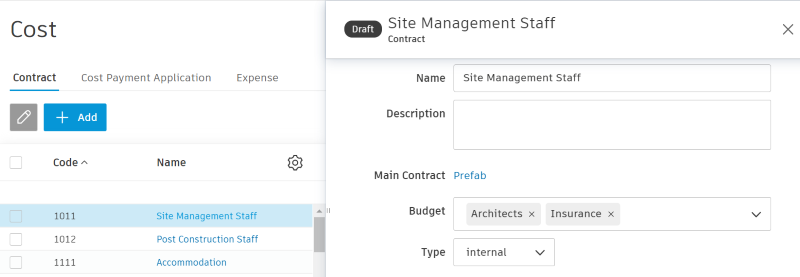
Add Zero-Amount Budget into an Executed Contract
Adding a zero-amount budget to an executed contract can help with cost tracking and historical reporting. It allows you to accurately reflect the actual costs incurred during the contract period, even if no additional funds were allocated.
To add a zero-amount budget into an executed contract:
Click the executed contract's name. The flyout panel opens.
Click Add Budgets in the Details section.

Choose one (or more) of the available zero-amount budgets.
Click Add.
Copy Supplier SOV Subitems to Main Contract
Some owners require that their payment applications reflect the exact schedule of value breakdown a general contractor gets from their subcontractors. However, the general contractor may not have some of their subcontractor SOVs established until later. Follow these steps to learn how to copy supplier contract SOV subitems to the main contract so the owner’s payment applications include the required information:
- Open a supplier's contract within the Contract sub-tab in the Cost tab.
- Scroll to the Schedule of Values section in the flyout panel and select the More menu
 . There you can manually add subitems or import an Excel list. Note, subitem amounts must equal the existing SOV amount.
. There you can manually add subitems or import an Excel list. Note, subitem amounts must equal the existing SOV amount.

Then:
- Go to the Main Contract sub-tab within the Budget tab and expand all.
- Navigate to the contract and open its flyout panel.
- Select the More menu
 to copy subitems to main contract.
to copy subitems to main contract.

The new SOV subitems will now display on the next owner payment application.
Import and Export Contract SOV
You can import and export contract SOVs using an Excel spreadsheet. This process can decrease the manual effort required to break down or update large numbers of Contract SOVs.
To import and export Contract SOVs:
Navigate to the Define Hierarchy menu.
To export, select Export Contract SOVs.
Open the exported file in Excel to update the SOVs, entering the desired values.
Save your changes to the Excel file.
In the Cost Management system, select Import Contract SOVs and choose the file you've just edited.
Click on Import. The system will maintain the sequence of the SOV items as they appear in your spreadsheet.
If new sub-items were added to the spreadsheet, they will be included in the import as well. After the import, you can manually create a Contract SOV with a tree structure, add or delete subitems, and move SOV items up or down.
After creating cost payment applications, you can revert Full Locked SOVs to an Unlocked status. This allows you to export all tree structures, update the Schedule of Rate (SOR), and import them again.
Send a Contract to a Supplier or Request Supplier Input
Now, you can send a contract to supplier's review:
In the flyout panel, click Send or Request Supplier Input. If there is an approval workflow set, there may be more than one approval needed.
Prepare a message for a supplier. Supplier contact must be specified on the contract and you can set that in the contract's flyout panel, in the Supplier Details section.
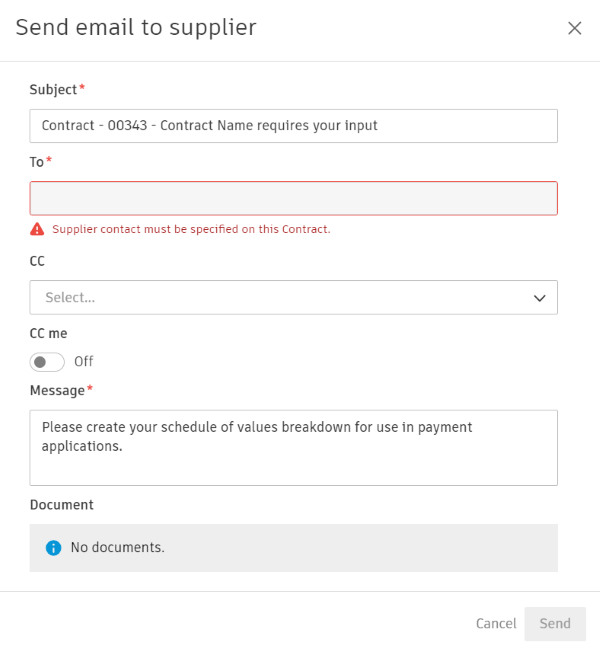
Click Send once ready.
A supplier will be notified of the contract for review by email when they have a collaborative permission for contracts.
Tip. Administrators can send a reminder to the supplier or owner to inform them that a response is awaited. To do that, click the Remind button.

As a supplier:
Open the email and select Open in Cost Management. When Cost Management opens, only the information pertaining to a supplier will be visible.
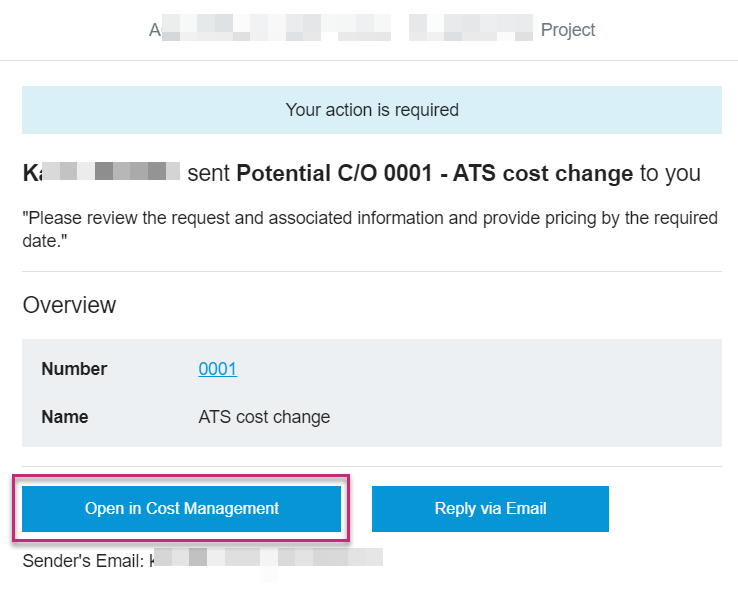
Select the contract name to open the flyout panel.
Scroll to review details, then select Respond in the workflow bar.

In the Schedule of Values (SOV) section, manually add or import the SOV items from Excel. If importing from Excel, select Download template to download an Excel template.

- Select the More
 menu to add, import, or delete subitems.
menu to add, import, or delete subitems. - Once the SOV information is complete, add comments for further context and select Submit.
Once submitted, the system will notify a general contractor by email. They can review and request revisions with comments.
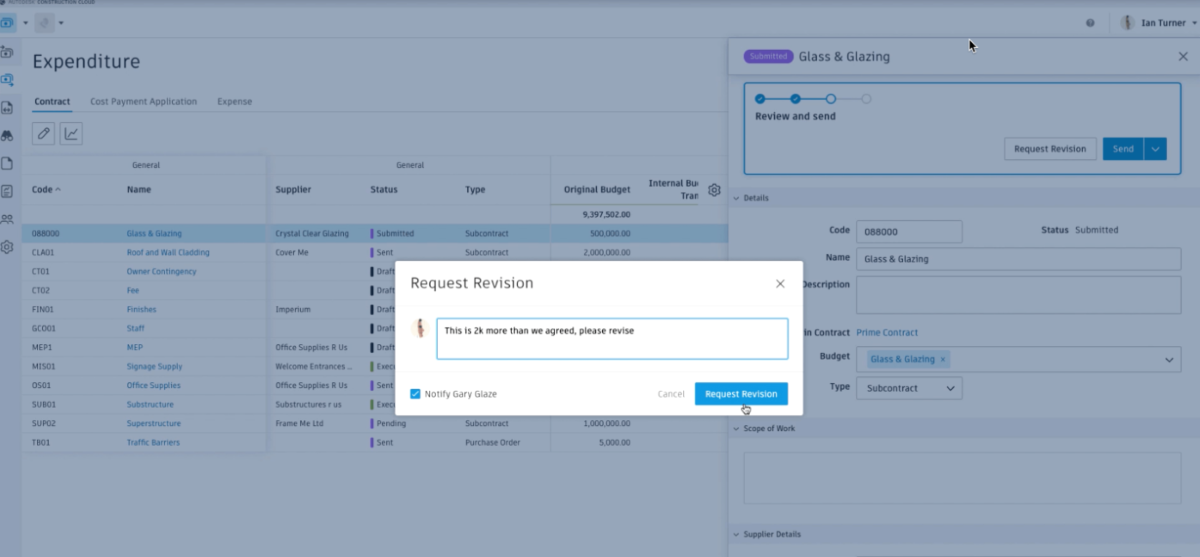
If a revision is required, the process will continue as outlined earlier once it is submitted back to a supplier. Once approved, a general contractor can compile the contract document package and send it over for signature.
Award the Contract in Foreign Currency
Once the foreign currency is set up, you'll see changes in the contract's flyout panel. The currency drop-down and exchange rate field are visible in the Details section.

To award the contract in foreign currency, choose it from the drop-down list:

Toggle between currencies in the Schedule of Values section to see the exchanged values in the Unit Cost, Amount, and Bulk Unit Cost columns. When a foreign currency is selected on a contract, the value can only be edited in the foreign currency. The currency name is shown as an indicator when editing:

A default exchange rate will be used based on when the Currency field is modified. You can change the exchange rate in Services and the flyout panel of the contracts, except for:
- At the Executed status
- Contract SOV is at the Integrated and Locked status. See the Lock Fields and Actions with an Integrated ERP System article to learn more.
Delete a Contract
To delete an existing contract:
Go to the Contract sub-tab within the Cost tab in Cost Management.
Click Edit Mode and then check the contract (or contracts) you want to delete.
Click Delete.

Confirm that you want to delete chosen contracts.
Contract Statuses
Typical contract status workflow:

Contracts have the following statuses:
- Draft: During the creation state of the contract. The flyout panel of the contract is fully editable. You can request a supplier's input, for example, to ask them to create their schedule of values breakdown for use in payment applications. You can also set the contract as Pending Supplier Input or send an informative-only email to a supplier.
- Pending Supplier Input: A notification email was sent to a supplier and the contract awaits their submission. If you set the compliance requirements' workflow, attaching compliance documents is mandatory to submit a contract.
- Submitted: The contract was reviewed and submitted. You can request revision again or send an email to a supplier.
- Revise and Resubmit: One from the party hasn't accepted the change order and requested revision. Check what is required and submit the revised contract.
- Sent: A notification email was sent to a supplier - the email is informative only. You can set the contract as executed or revert it to the Submitted status.
- Executed: The contract is executed by the project administrator. It can be reverted to the Sent status or set as closed. Some of the fields are locked when the contract is in the Executed status. Go to the Lock Fields and Actions ERP Integrated ERP System article to see more details.
- Closed: The contract is by the project administrator set as closed.
View Full Contract Page
When the contract SOV root nodes exceed hundreds of items, having the full-screen view makes it easier to visualize the data.
Expand Supplier SOV to Full Page
There are two ways to expand the SOV section of a specific contract to full screen:
- Hover over the contract row and select the expand icon.
- Open the contact flyout and select View in full page button within the Schedule of Values section.

Once in full page view, select the filter icon to group by budget code segment. Also, custom views can be saved for later for quick referencing within this view. See Filter and Group for more information.
View SOV Evolution
Within the contract full page view:
Click the More menu
 and choose to view change orders as a column.
and choose to view change orders as a column.
Using the gear
 icon on the right, turn on the designed columns under Revised Values. This view auto aligns Original Budget, Scheduled Value (SOV), Change Orders, and Revised Values.
icon on the right, turn on the designed columns under Revised Values. This view auto aligns Original Budget, Scheduled Value (SOV), Change Orders, and Revised Values. 
Alignment between original and changes is defined by having identical item code and name. This will be done automatically when a change in the order cost item hierarchy has been generated from the contract SOV. It can also be done with manual entry.
Imagine a scenario in which you purchase material in bulk and need to reflect this pricing accordingly in the contract purchase order SOV. You can turn on new columns: Qty Per Bulk, Bulk, and Bulk Unit Cost using the gear icon ![]() on the right:
on the right:
- In the QTY column, members can enter the total number of fittings.
- In the Qty Per Bulk column, members can enter the qty of fittings per box.
- In the Bulk Unit Cost column, members can enter unit cost of each bulk.
- The Bulk column calculates the bulk units required.
The sample contract template also includes an option to use the bulk columns and use the bulk unit cost instead of per fitting. See Create and Manage Document Templates to learn how to download and edit contract templates.
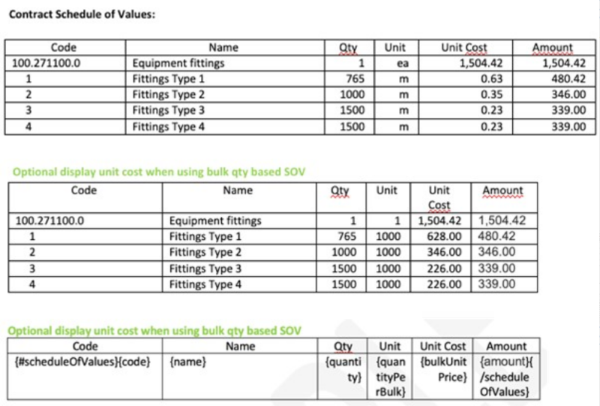
Export a Contract Report
You can create a formatted report of contract tables. First, you can filter and group contracts to get the information you need. Then, follow these steps:
Select the Cost tab.
Switch to the Contract subtab.
Click
 .
.Enter the report title and choose between PDF Report and Excel Report.
Decide whether you need a title page and choose the report template:
Current View - includes all currently visible columns. Use this one to create a report for filtered contract table views or previously saved current views.
Tip: When exporting a PDF or Excel budget report in edit mode, the system will only export currently visible columns.
Click Run report.
